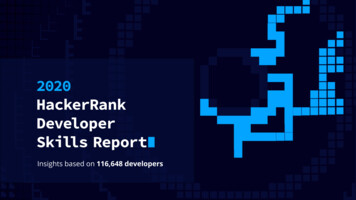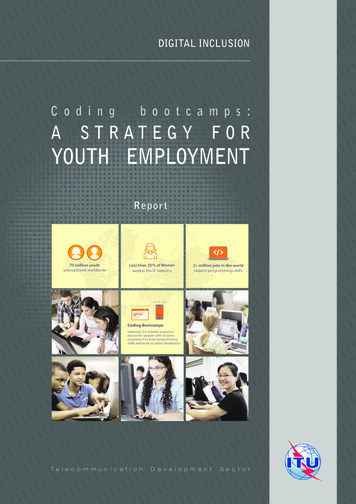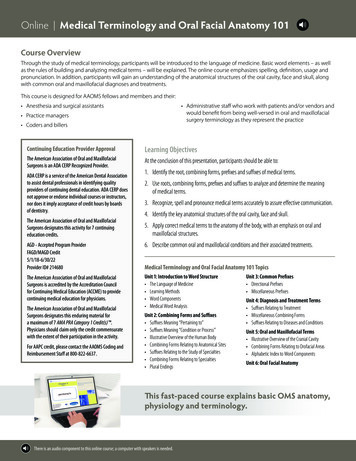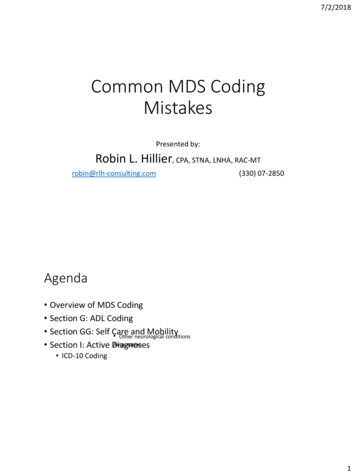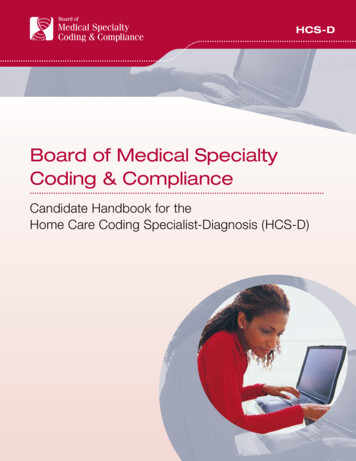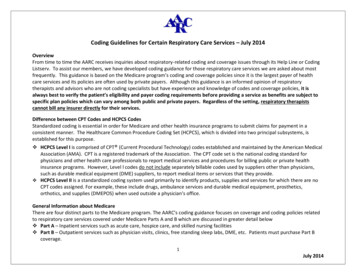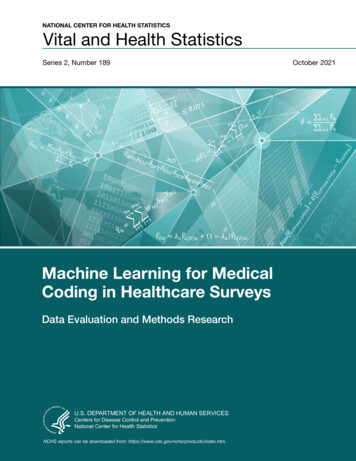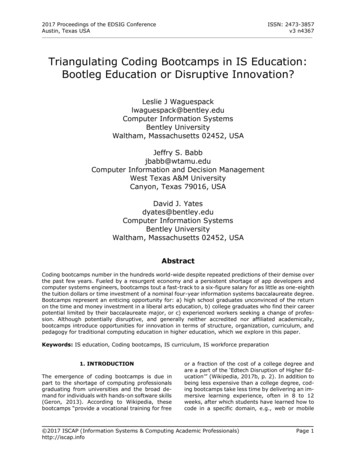
Transcription
2017 Proceedings of the EDSIG ConferenceAustin, Texas USAISSN: 2473-3857v3 n4367Triangulating Coding Bootcamps in IS Education:Bootleg Education or Disruptive Innovation?Leslie J Waguespacklwaguespack@bentley.eduComputer Information SystemsBentley UniversityWaltham, Massachusetts 02452, USAJeffry S. Babbjbabb@wtamu.eduComputer Information and Decision ManagementWest Texas A&M UniversityCanyon, Texas 79016, USADavid J. Yatesdyates@bentley.eduComputer Information SystemsBentley UniversityWaltham, Massachusetts 02452, USAAbstractCoding bootcamps number in the hundreds world-wide despite repeated predictions of their demise overthe past few years. Fueled by a resurgent economy and a persistent shortage of app developers andcomputer systems engineers, bootcamps tout a fast-track to a six-figure salary for as little as one-eighththe tuition dollars or time investment of a nominal four-year information systems baccalaureate degree.Bootcamps represent an enticing opportunity for: a) high school graduates unconvinced of the returnon the time and money investment in a liberal arts education, b) college graduates who find their careerpotential limited by their baccalaureate major, or c) experienced workers seeking a change of profession. Although potentially disruptive, and generally neither accredited nor affiliated academically,bootcamps introduce opportunities for innovation in terms of structure, organization, curriculum, andpedagogy for traditional computing education in higher education, which we explore in this paper.Keywords: IS education, Coding bootcamps, IS curriculum, IS workforce preparation1. INTRODUCTIONThe emergence of coding bootcamps is due inpart to the shortage of computing professionalsgraduating from universities and the broad demand for individuals with hands-on software skills(Geron, 2013). According to Wikipedia, thesebootcamps “provide a vocational training for freeor a fraction of the cost of a college degree andare a part of the ‘Edtech Disruption of Higher Education’” (Wikipedia, 2017b, p. 2). In addition tobeing less expensive than a college degree, coding bootcamps take less time by delivering an immersive learning experience, often in 8 to 12weeks, after which students have learned how tocode in a specific domain, e.g., web or mobile 2017 ISCAP (Information Systems & Computing Academic Professionals)http://iscap.infoPage 1
2017 Proceedings of the EDSIG ConferenceAustin, Texas USAISSN: 2473-3857v3 n4367software development. Some programs even gointo more depth within a domain, e.g. front-enddevelopment, iOS, Android or cloud-native development, and some offer a portfolio of such programs. Since most students prefer to learn aspart of a community, especially during an immersive (and intense) experience, there are manymore classroom-based than on-line bootcamps.Employing in-person cohorts like their militarynamesake, they offer emotional and psychological support that engenders a sense of confidenceand professionalism (Barnett, Basom, Yerkes, &Norris, 2000). And, presumably for job placementreasons, these programs tend to cluster in population centers with a significant presence of technology companies. In the United States, forexample, many of the well-known bootcampshave classrooms in San Francisco and New York.Recent diversification away from “just coding”bootcamps has given rise to camps focused onapplications, e.g. data analytics, and infrastructure, e.g. Internet of Things.So, since their inception in 2012, how are thesealternative education programs doing? A surveyofmostU.S.graduatesconductedbySwitchUp.Org (2017a), draws the following conclusions based on data gathered from 2014 to2016: 63% of code bootcamp graduates reportedincrease in salary (in 2016 the average annual salary increase six months after graduation was more than 22,000);80% of graduates were satisfied with theirbootcamp education (just under 15% weredissatisfied);Average class size is 30 with a 1-to-3.8 student instructor ratio;Coding bootcamps are a far cheaper and accelerated option than learning to code at auniversity (the average bootcamp took 10.8weeks in 2016 and cost 12,800);Women learning how to code represent 43%of the bootcamp alumni; andThe bootcamp market is growing rapidly, projected to double from 2016 to 2017.This report goes on:“There is no doubt that 21st century technology education is trending towards transparent, outcome-driven metrics. However,key questions remain: Can the type of salaryincrease seen from the data be sustained inthe long-term? As the supply of developersincreases to match the demand, will the jobmarket get tighter, or will the creation oftech jobs continue to outmatch the supply ofdevelopers over the next few years?”(SwitchUp.Org, 2017a, p. 7)2. WHAT IS A BOOTCAMP?Coding bootcamps offer technology-focusedtraining programs that teach programming,frameworks, systems and tools which are in demand in many entry-level software developer positions. Most of these programs teach people withlittle or no technical coding background how tocode, build and deploy applications.Most information systems and computer sciencestudents spend four years to complete their degree. Code bootcamps are designed to distill skillsfrom a four-year degree that are in the greatestmarket demand and infuse them with relevantmethodologies and practices to bridge the perceived gap between contemporary academia andthe real world of professional coding (Janicki,Cummings, & Kline, 2014; Yourdon, 2002). Withan average program duration of less than 11weeks, this requires a combination of a singularfocus on high demand skills and technologies andhigh-impact learning with no frills.As for colleges and universities, there are differences in how different coding bootcamps teachand prepare their students to enter the technology workforce. Because bootcamps lack oversightby federal and state governments or by accrediting bodies, any assessments or judgements abouttheir quality are largely anecdotal. Many differentiating themes that emerge in both favorable andunfavorable anecdotes, however, are familiar tothe EDSIG membership and EDSIGCON audience: Quality and focus of the curriculum;Technical training and know-how of instructors;Number of full-time vs. part-time instructors;Quality of instruction;Emphasis on group projects that simulatereal-world development; andAvailability of mentorship and tutoring forstudents.3. BOOTCAMPS AS COMPUTING PROGRAMSIf nothing else, coding bootcamps represent adistinct departure from the prevalent models ofcareer preparation followed by tradition institutions of higher education. A technology focus isobvious in a 2017 ranking of coding bootcampsby an industry monitoring website, SwitchUp.org 2017 ISCAP (Information Systems & Computing Academic Professionals)http://iscap.infoPage 2
2017 Proceedings of the EDSIG ConferenceAustin, Texas USAISSN: 2473-3857v3 n4367(2017b), that identifies “The Best of 2017.” Table 1 lists their ranking of 31 coding bootcampsand the “catalog” of technology training advertised by each.Table 1. Code Bootcamp Technology CoursesIn contrast, even the most technically orientedacademic programs in colleges and universitiesrequire a significant investment of time and effort to develop a “liberally educated” citizenry.The Association of American Colleges and Universities expresses this model of liberal education thusly:Achieving the breadth of study ascribed to a liberal education involves on the order of 120 to 140academic credit hours. Each credit hour unittranslates into 15 hours of class time and 30hours of student preparation, according to theU.S. Department of Education, International Affairs Office (USDoE, 2008).In Table 2 that follows, the contrast between curriculum models, a typical twelve-week codingbootcamp versus the IS degree programs targeting two-year associate and four-year baccalaureate degrees, is dramatic (NCES, 2017).Also, the difference in the student’s overall program cost is significant, 1/4th to 1/8th the cost ofan associate program or 1/5th to 1/10th the costof a baccalaureate program. But, the most compelling differences are entailed by the singular focus of bootcamps on software development,programming. By eschewing the breadth aspectof the liberal education, the bootcamps typicallyrequire no study of the humanities, sciences, orpost-secondary mathematics. In contrast to college programs in IS, by concentrating exclusivelyon code development and technical IT skills, thebootcamp applies virtually all the contact hours ofinstruction to coding related topics: more thantwice the contact hours typically devoted to coding in the associate degree and nearly 80% morethan in the baccalaureate degree. Furthermore,the bootcamp requires only about three calendarmonths rather than four or eight twelve-week semesters spanning two to four years for the associate or baccalaureate programs, respectively.“An approach to college learning that empowers individuals and prepares them todeal with complexity, diversity, and change.This approach emphasizes broad knowledgeof the wider world (e.g., science, culture,and society) as well as in-depth achievementin a specific field of interest. It helps studentsdevelop a sense of social responsibility;strong intellectual and practical skills thatspan all major fields of study, such as communication, analytical, and problem-solvingskills; and the demonstrated ability to applyknowledge and skills in real-world settings.”(AACU, 2014, p. 1)The AACU reported that 74% of surveyed employers in 2013 recommended this model of liberal education for college-bound students.Table 2. Bootcamp vs. IS Program Comparison 2017 ISCAP (Information Systems & Computing Academic Professionals)http://iscap.infoPage 3
2017 Proceedings of the EDSIG ConferenceAustin, Texas USAISSN: 2473-3857v3 n4367Triangulating Coding Bootcamps in the Curricular Geography of CC2005The singularity of focus that bootcamps exhibit isfurther demonstrated in the curricular focuswithin the domain of computing education. TheAssociation for Computing Machinery, ACM, andthe Institute for Electrical and Electronics Engineering, IEEE, have consistently worked to normalize the structure and evolution of computingeducation through a series of published curricularguidelines for particular computing disciplines(CS, CE, IT, IS, and SE), as well as mapping theoverall landscape as it did with Computing Curriculum 2005, CC2005 (Shackelford, McGettrick,Sloan, Topi, Davies, Kamali, Cross, Impagliazzo,LeBlanc, & Lunt, 2006, pp. 6-21). In that CC2005report (the most recent and comprehensivecross-discipline analysis), the task force createdgraphic characterizations of “what students ineach of the disciplines typically do after graduation.” Each discipline is portrayed on a field ofcompetency as a “footprint” of proficiency gainedby completing the respective academic program.(See Figure 1.)communications (Liu, 2000; Stamper, 1973,1988). (See Figure 2.) Ascent along the Y-axis ofthe field of competency (Figure 1) entails a progressive amplification of domain modeling skillsand contextualized interpretation requiring acommensurate proficiency in dealing with thecomplexity of the social context.Figure 1 - CC2005 Field of ComputingCompetencyAlthough our discussion focuses on thejusxtaposition of coding bootcamps and ISeducation, we include the footprint of computerscience in Figure 3 as an orienting referencepoint. CS graduates may be engaged in purelytheoretical work ranging from efficient utilizationofhardwarecomponentstosystemsmanagement supported by machine learning. CSgraduates are not generally engaged in off-theshelf systems deployment or configuration. Theyare seldom responsible for organizational policyor design of low-level hardware for informationinfrastructure.The field of competency delineates computing activities ranging on the Y-axis from hardware issues on the bottom to organizational policy andinformation management at the top. The X-axisdepicts purely applied involvement in computingactivities to the far right to purely theoretical engagement of computing topics to the left.To emphasize the degree of abstract conceptualization required to bridge between the physicaland social world of computing as depicted alongthe vertical dimension, we superimpose the semiotic ladder as exposed by the footprint of the respective CC2005 discipline. A semiotic frameworkexplicates the expression and transmission ofideas, knowledge, and meaning through humanFigure 2 - Semiotic Continuum of ConstructsThe framework (aka semiotic ladder) depicted inFigure 2 orients and categorizes logical landscape that information systemsdesign practice must navigate. The “ladder”represents layered abstractions progressingcontinuously from bottom to top, anticipatingcomponents both material and conceptualarranged as layers of scaffolding one atop theother. Each layer anticipates building blocks in agradient of abstraction, a vocabulary ofmetaphoricalconstructs.Eachlayerisreminiscent of a virtual machine encapsulatingthe details of the supporting layers to present ahomologous array of structural and behavioralresources upon which to examine the dialogbetween IS developers and IS consumers. 2017 ISCAP (Information Systems & Computing Academic Professionals)http://iscap.infoPage 4
2017 Proceedings of the EDSIG ConferenceAustin, Texas USAISSN: 2473-3857v3 n4367Figure 3 - Competency Target of CS (2005)In CC2005’s characterization of the activity of ISgraduates, the full breadth of organizationalinformation management policy and operationalsystems management appears without asignificant involvement in hardware or softwaredevelopment theory and practice. (See Figure 4.)Software development is confined to applicationsand the configuration and deployment of off-theshelf computing resources focussing largely onsupporting business policies and functions.Figure 5 - Competency Target of IS2010Bootcamps have never been a curricular focus ofthe ACM or IEEE guidelines efforts in the mode ofCC2005. However, we posit here a footprintdepicting the competency target of codingbootcamps in Figure 6 as a means to visualizeaspects of the relationship between bootcampsand IS curricula.Figure 6 - Competency Target of BootcampsFigure 4 - Competency Target of IS (2005)In our interpretation of the most recent IScurriculum guideline, IS2010, that task forceappears to have interpreted the engagement ofIS graduates as receding from direct engagementin software development by assuming a moreconsumer relationship with software systems(Topi, Valacich, Wright, Kaiser, Nunamaker,Sipior, & Vreede, 2010). (See Figure 5.) The taskforce appears to have envisioned IS graduatesmore focused on business systems as operationalsupport by adopting a greater dependence uponthird-party or out-sourced systems developmentrather than as builders themselves of strategicartefacts of business.Bootcamps are purposefully quite “singleminded.” They focus on individual computingtechnologies confined primarily to software production. Their goal is skill-building, rather thanproblem shaping or theorizing. The problem environment is usually fixed in terms of technology,platform, and tool set. The bootcamp goal is toproduce an efficient, reliable, “construction”worker. While there is likely significantly moreroom to extend professional skill in the realm ofsoftware construction, it is clear that industryneeds people who can “hammer nails” and “sawwood” rather immediately, hence the bootcampphenomenon.Bootcamps vs Accredited Curricula and ProgramsWhile the value of accreditation in higher education is the subject of disparate opinions, nonetheless institutions, schools, programs and curricula 2017 ISCAP (Information Systems & Computing Academic Professionals)http://iscap.infoPage 5
2017 Proceedings of the EDSIG ConferenceAustin, Texas USAISSN: 2473-3857v3 n4367each can be (and are often) accredited and suchaccreditation becomes a mark of quality for various parties: governments, industry, consumers,and citizens (Eaton, 2000, 2012).As this paper is targeted to faculty in informationsystems (IS) and computing disciplines, we specifically reflect upon the influence and impact ofboth AACSB and ABET accreditation. While it isnot the case that all IS programs would be eitherhoused in a college of business, nor would theynecessarily be accredited by either AASCB (forbusiness) or ABET (computing), these accreditation bodies serve as reasonable proxies by whichwe may understand the influence that these, andregional and national accreditations, have on curricula and the programs that deliver them.In the case of AACSB, accredited schools areasked to articulate, measure, evaluate, and improve upon key learning goals for all of programsthat fall under the auspices of accreditation suchthat specified standards are met and maintained.The standards, as is often the case also with regional accreditations, apply to the breadth of activities that extend beyond curriculum. However,the direct and indirect impacts of these standardson curriculum are certainly an intentional byproduct (Gray, Smart, & Bennett, 2017; Solomon,Scherer, Oliveti, Mochel, & Bryant, 2017). Nonetheless, the guidance for curricula, as a component of learning and teaching, are general andbroad. Thus, AACSB will examine the processesthat lead to a curriculum that focuses on relevantskills and knowledge expected of a particular degree program, any specifics are left to faculty execution of their processes. Thus, while the 2017specification of AACSB Standard Eight requires anarticulation of learning goals which are mappedinto course content whereupon some assurancesof learning are adhered in a process of curriculummanagement, these are processes without specificity of content. AACSB Standard Nine providessome expectation that content is consistent withwhat is normative to a degree program – citing arequisite to care for theories, ideas, concepts,skills, and knowledge, these are to be establishedin the college.As many Information Systems curricula havesome organizational component, the generalbusiness knowledge areas specified by AACSB inStandard Nine would naturally cover some portion of what can be articulated as an InformationSystems curriculum. The ACM and AIS CurriculumGuidelines for Undergraduate Degrees in Information Systems (Topi et al., 2010) is the latestinstallment in a long line of IS curricula guidelinesdesigned to fill in the gaps which, particularlythose topical to computing, are not addressed byAACSB. Such model curricula espouse principlesregarding what a “standard” IS curriculum mightlook like while also leaving space for local specializations and adaptations. While not without somecontroversy regarding the degree of specificationof technology content (Longenecker, Feinstein, &Babb, 2013; Reynolds, Adams, Ferguson, & Leidig, 2017; Waguespack, 2011), IS2010 madesome clear vital elements, such as data and information management, infrastructure, and Systems Analysis and Design, among others.With respect to IS curricula, ABET also providesguidelines for programs seeking to acquire andmaintain a program-level accreditation. The specifics of the ABET’s Computing Accreditation Commission (CAC) extend beyond that provided in theIS2010 report, while perhaps providing less justification and philosophy behind the specifics. The2017-2018 CAC criteria specify both content –one year or, typically, 10 courses that cover basiccontent such as: coverage of the fundamentals ofapplication development, data management, networking and data communications, security of information systems, systems analysis and designand the role of information systems in organizations. Within that year’s coverage is included advanced coursework to extend these fundamentaltopics, coverage of a professional environment inwhich information systems will be applied – oftenin business - and also quantitative methods andstatistics.The cross-verifying (and validating) and interleaving nature of these externally-validated accreditations on IS curricula are clear. What is lessclear is the degree to which bootcamps areproviding similar, if not better, grounding in thetechnical components of an IS curriculum. Whilethe advantages of a college education, even incomputing, are somewhat established in the marketplace (Carnevale, Cheah, & Strohl, 2013), it isreasonable to ask what advantages coding andtechnology bootcamps pose? This question is particularly poignant as there is growing evidencethat the labor market may not continue to givepreference to the fruits of “traditional” higher education over two-year degrees, diplomas, certificates, MOOCs, and now coding bootcamps(Jepsen, Troske, & Coomes, 2014).Deciphering a Bootcamp AdvantageIt is fair to say that bootcamps are dedicated toproviding the maximum of “knowing how” withthe minimum of “knowing that” with virtually noattention to “knowing why” (Claxton, 1997)! To 2017 ISCAP (Information Systems & Computing Academic Professionals)http://iscap.infoPage 6
2017 Proceedings of the EDSIG ConferenceAustin, Texas USAISSN: 2473-3857v3 n4367achieve their teaching goal of “knowing how,”bootcamps employ three tactics: a) topic isolation, b) cohort cohesion, and c) practice immersion.Topic Isolation: Unlike college or university philosophies that blend a disciplinary focus into acontext of liberal studies, bootcamps identify andisolate their curriculum and pedagogy concentrating on the tools and skill set of a niche softwaredevelopment task domain. Common domains arewebsite development, client side or server sideprogramming, mobile device apps, and platformbased application development environments(e.g., LAMP Stack, Ruby on Rails, JavaScript,Java, C#, HTML, CSS, ASP.NET, Python, Swift,iPhone, Android, etc.). (See Table 1.)Cohort Cohesion: The bootcamp environment engages the group-learn ethic of its military namesake. Working shoulder-to-shoulder with classmates who virtually all are aiming at the identicalacademic and tactical goal of IT employment, students gain comrades and competitors with whomand from whom to learn, and draw energy to holdfast to the intense and often grueling 40-hourplus class weeks. The group familiarity gained inthe early weeks of the bootcamp foreshadow theproximity that industrial-strength developmentexperiences will engender. At the same time, cohorts offer opportunities to learn team communication and leadership lessons unscripted in thebootcamp curriculum.Practice Immersion: The typical 40-hour classweek provides the close-up demonstration of introduction to explanation to demonstration to exercise to evaluation in a cycle that within a cohortprovides an academic variant of close order drill,“the memorizing of certain actions through repetition until the action is instinctive to the soldiersbeing drilled.” (Wikipedia, 2017a) At the sametime there is the opportunity in the presence ofthe instructor to immediately validate understanding of the introduction and explanation byseeing the technology demonstrated as implemented and then engage a development behaviorto replicate the implementation. All this pedagogyproceeds while suppressing the disruptive intervention of days separating class sessions or attention distracted by the study of topics otherthan the technology subject at hand. These characteristics may accrue advantages that are worthy of further examination in our own community.4. EXPLOITING BOOTCAMPS AS I.S.CURRICULAR RESOURCESThe natural reaction of college computing programs to coding bootcamps might be to “man thebulwarks” and mount maximum resistance totheir rising popularity. Or, higher education might“write off” bootcamps as a philosophically inferiorapproach to education. But honestly, bootcampspose a tempting alternative for career entry to thecomputing profession – not only to the studentmarket, but also to a parental and legislative audience growing skeptical of the cost / benefit orreturn on investment of traditional higher education.The fact is that for some time now, there persistsa demonstrated shortfall of skilled software developers in the job market (Geron, 2013). Mostacademics would consider bootcamps a myopicchoice, but, bootcamps can equip a committedhigh school graduate, disillusioned liberal arts degree holder, or a working professional tired oftheir current career the opportunity to enter thecomputing career field. But, is there an opportunity for academic programs, particularly IS, totake advantage of this emerging model of programming education?Figure 7 - Competency Target of IS (2010) Code BootcampA quick overlay of the posit we offer for thebootcamp footprint of competency onto that ofIS2010 indicates that there is relatively little redundancy. (See Figure 7.) In fact, the combination is reminiscent of the IS footprint of CC2005,suggesting that perhaps some opportunities forcurricula innovation present themselves.IS Graduates Need Development SkillsMost IS programs envision their graduates’ careerentry into computing aligned with, if not embedded in, software systems development. To thatend, even with the departure of software development requirements from IS with the IS2010guidelines, most undergraduate IS programs today find it imperative to offer at least enoughsoftware development coursework to legitimize aplace for that skill on their graduate’s résumé.Relatively few IS graduates will place in positions 2017 ISCAP (Information Systems & Computing Academic Professionals)http://iscap.infoPage 7
2017 Proceedings of the EDSIG ConferenceAustin, Texas USAISSN: 2473-3857v3 n4367that are primarily managerial or supervisory without some experience with programming responsibilities. Therefore, training for softwaredevelopment skills remains for the foreseeablefuture as requisite to career entry for IS graduates.Teaching Coding Skills Costs IS TwiceSupporting software development coursework isdoubly expensive for IS programs:want to explore internship, scholarship and mentorship arrangements to access the best andbrightest prospects. These businesses may wantto influence the bootcamp curricula regardingtools and skills appropriate for their informationtechnology strategies, as well as, opportunities toupgrade or retrain the skill sets of their currentemployees.5. DISCUSSIONa) Consumingpreciouscredithourssqueezed into business school programsdealing with the pressures for maintainingbreadth in liberal arts within the strictures ofbusiness program accreditation; and,Our exploration of coding bootcamps is not intended to malign or endorse the phenomenon,but rather to consider the challenges and opportunities. To summarize, we conclude with a simple SWOT analysis.b) the complexities of software developmentinstruction that levies on faculty a burden oftechnical preparation and individualized student engagement that are not easily alignedwith the models and areas of research promoted as flagship academic scholarship.Strengths. We have elucidated the strengths ofthe code bootcamps as being very focused onspecific technologies which are immediately valued and favored in the marketplace. Often located in population and technology hubs, thecamp-to-employer food chain is compelling forthe employer. These are fresh students who areready to go with the timely skills required at anentry level. With career-switchers, employers getsome of the polish and seasoning of work experience, which is generally favored in most industries evidenced in a lower unemployment rate forthose with experience in almost any industry(Jepsen et al., 2014).Search for a Win-Win SituationExploring ways to coopt bootcamps that teachcoding skills may be mutually beneficial if theycan: a) provide superior coding skill outcomes forstudents compared to the limited curricular resource for it in college and university programs,and b) lifting the training burden from IS facultystruggling to maintain a successful balance ofteaching and research, both of which aregrounded not in the computing but rather, thebusiness disciplines where the primary standardsof faculty evaluation reside. Some possible approaches are outsourcing software developmentskills training by accepting bootcamp completionfor college credit as liberal arts coursework or asfulfilling some other distribution requirement, orinsourcing the training as a summer intensive offering by the college. The latter might use underutilized housing and laboratory facilities andbe staffed by a combination of practicing professionals, accomplished upper class students, andsupervisory staff.Teaming Up to Address the Skills GapArticulation agreements between bootcamps andIS programs can function as bilateral recruitingfunctions. Bootcamps can recommend IS programs for degree completion once their reachtransition points in their development careers.And, colleges can recommend bootcamps as “testdrives” for undecided students unsure of the twoyear or four-year commitment to college. In either case, local businesses strapped by a shortage of programmers and app developers mayWeaknesses. Relative to the long-standing inertiaof experience that traditional college-orientedprograms and curricula in computing enjoy, therewill likely be a wide range of providers and standards (or lack thereof) as the code bootcamp innovation diffuses and competition among providersincreases. With no oversight, these bootcamps already deliver up mixed results with little recoursefor students that feel short-changed. US Department of Education actions sanctioning ITT Technical University for fraudulent practices may be acautionary tale here as we have witnessed somedrawbacks in for-profit higher education (Morey,2004).Opportunities. As we have indicated earlier, twoyear, four-year, and graduate institutions havethe longstanding expertise in providing effectiveinstructional environments. While many of thesecoding b
alternative education programs doing? A survey of most U.S. graduates conducted by SwitchUp.Org (2017a), draws the following con-clusions based on data gathered from 2014 to 2016: 63% of code bootcamp graduates reported increase in salary (in 2016 the average an-nual salary increase six months after gradua-tion was more than 22,000);

